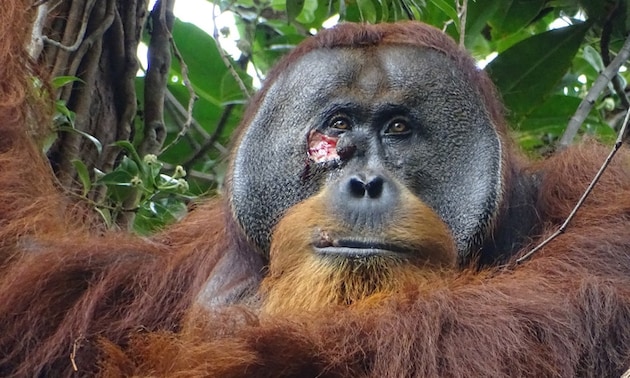An orangutan has successfully treated a wound on its face with chewed leaves of a medicinal plant. It is the first time that a wild animal has been observed doing this.
From time to time, scientists observe wild animals eating, chewing, or rubbing plants or animals with medicinal properties on their skin and fur. Among the primates, these include chimpanzees, bonobos, gorillas, gibbons and orangutans. In this way, they actively or preventively ward off parasites, infections or other diseases, as previous studies show. Chimpanzees in Gabon may even use insects to treat wounds. However, their effect has not yet been clearly proven.
Now a research team led by Isabelle Laumer from the Max Planck Institute (MPI) for Behavioral Biology in Konstanz has, for the first time, observed a wild animal using a proven healing plant to treat a fresh wound. In June 2022, the biologists observed a male orangutan (Pongo abelii) in Gunung Leuser National Park on Sumatra, Indonesia, chewing on leaves and branches of the climbing plant Akar Kuning (Fibraurea tinctoria) – a plant rarely eaten by orangutans Plant.
The ape, named Rakus, repeatedly applied the liquid produced by chewing on the medicinal plant with his fingers to a three-day-old wound on his right cheek. The orangutan rubbed the plant sap into its wound for a total of seven minutes, as the team observed. He then covered the wound with the chewed plant tissue and ate leaves from the vine for another half hour. The day after, he also ate the leaves of the plant for two minutes, but not on any of the following days.
The effect of this wound treatment became apparent in the following days: the biologists observed that the wound did not become infected but healed well. The usual accumulation of flies at the injured area also did not occur. The wound was closed within five days and healed completely within a month, as Laumer and her team report.
From previous studies, Akar Kuning is known to have medicinal properties due to various ingredients. The climbing plant is effective against inflammation, fever and pain as well as against infections caused by bacteria or fungi. The liana is therefore used in traditional Asian medicine to heal wounds and against diseases such as dysentery, diabetes and malaria.
Laumer and her colleagues conclude from Raku’s behavior that the orangutan had deliberately and intentionally treated his wound – which he probably sustained during a fight with a rival – with the “herbal ointment”. The team suspects that the plant sap and chewed leaves may have relieved his pain and accelerated wound healing. They may also have kept the flies away. “Interestingly, Rakus also rested more than usual when he was injured,” says Laumer. “Sleep has a positive effect on wound healing.”
For the researchers, this is the first and only observed case in Indonesia in which an orangutan used Akar Kuning to treat wounds. However, this could be because injured animals are rarely seen in this part of Sumatra. It is therefore unclear whether Rakus used the plant for the first time to treat a wound or had previously copied the behavior from a member of its species.
“It is possible that wound treatment with Fibraurea tinctoria in the orangutans in Suaq arises through individual innovation,” says senior author Caroline Schuppli from the MPI for Behavioral Biology. “It could happen that individuals accidentally and unintentionally apply the plant sap to their wounds while eating.” The immediate pain relief they experience could then lead them to repeat this behavior.
According to the biologists, the observation suggests that common ancestors of great apes and humans could have used medicinal plants. Accordingly, monkeys have long had medical healing knowledge. “The study provides new insights into the existence of self-medication among our closest relatives and into the evolutionary origins of wound medication more broadly,” write Laumer and her colleagues.
The oldest reports of people cleaning, anointing and dressing wounds are around 4,200 years old. “It is possible that there is a common underlying mechanism for recognizing and applying substances with medicinal or functional properties to wounds and that our last common ancestor already exhibited similar forms of behavior,” the team said. (Scientific Reports, 2024; doi: 10.1038/s41598-024-58988-7)
Source: Max Planck Society
By Claudia Krapp
Anyone who notices a red face after drinking alcohol should take care of themselves. Because there could be alcohol intolerance behind it. And that can increase the risk of certain types of cancer.
Despite their advanced age, super-agers have above-average mental fitness. Their memory performance is as good at the age of 80 as it is at the age of 50 or 60. What is their secret?
The original for this article “Observed in wild animals for the first time: Orangutan treats wound with medicinal plant” comes from scinexx.









